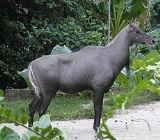
Boselaphini
Encyclopedia
Boselaphini is a tribe
of antelope
s belonging to the subfamily Bovinae
of the family
Bovidae. It contains only two extant genera
.
tribe are the last survivors of a form very similar to that of the ancestors of the entire subfamily.
Both extant species have relatively primitive anatomical and behavioural characteristics and the females have no horns. They are native to the rapidly diminishing forests of India
, and tend to avoid open plains. The nilgai
has been introduced into southern Texas
where a population of a little under 15,000 animals provides some long-term insurance for its survival.
Tribe Boselaphini
Tribe (biology)
In biology, a tribe is a taxonomic rank between family and genus. It is sometimes subdivided into subtribes.Some examples include the tribes: Canini, Acalypheae, Hominini, Bombini, and Antidesmeae.-See also:* Biological classification* Rank...
of antelope
Antelope
Antelope is a term referring to many even-toed ungulate species indigenous to various regions in Africa and Eurasia. Antelopes comprise a miscellaneous group within the family Bovidae, encompassing those old-world species that are neither cattle, sheep, buffalo, bison, nor goats...
s belonging to the subfamily Bovinae
Bovinae
The biological subfamily Bovinae includes a diverse group of 10 genera of medium to large sized ungulates, including domestic cattle, the bison, African buffalo, the water buffalo, the yak, and the four-horned and spiral-horned antelopes...
of the family
Family (biology)
In biological classification, family is* a taxonomic rank. Other well-known ranks are life, domain, kingdom, phylum, class, order, genus, and species, with family fitting between order and genus. As for the other well-known ranks, there is the option of an immediately lower rank, indicated by the...
Bovidae. It contains only two extant genera
Genus
In biology, a genus is a low-level taxonomic rank used in the biological classification of living and fossil organisms, which is an example of definition by genus and differentia...
.
Description
The Boselaphini or four-horned antelopeAntelope
Antelope is a term referring to many even-toed ungulate species indigenous to various regions in Africa and Eurasia. Antelopes comprise a miscellaneous group within the family Bovidae, encompassing those old-world species that are neither cattle, sheep, buffalo, bison, nor goats...
tribe are the last survivors of a form very similar to that of the ancestors of the entire subfamily.
Both extant species have relatively primitive anatomical and behavioural characteristics and the females have no horns. They are native to the rapidly diminishing forests of India
India
India , officially the Republic of India , is a country in South Asia. It is the seventh-largest country by geographical area, the second-most populous country with over 1.2 billion people, and the most populous democracy in the world...
, and tend to avoid open plains. The nilgai
Nilgai
The nilgai , sometimes called nilgau, is an antelope, and is one of the most commonly seen wild animals of central and northern India and eastern Pakistan; it is also present in parts of southern Nepal. The mature males appear ox-like and are also known as blue bulls...
has been introduced into southern Texas
Texas
Texas is the second largest U.S. state by both area and population, and the largest state by area in the contiguous United States.The name, based on the Caddo word "Tejas" meaning "friends" or "allies", was applied by the Spanish to the Caddo themselves and to the region of their settlement in...
where a population of a little under 15,000 animals provides some long-term insurance for its survival.
Genera
The following are the genera classified under the tribe. Genera marked with † are extinct.Tribe Boselaphini
- Boselaphus
- Boselaphus tragocamelus - NilgaiNilgaiThe nilgai , sometimes called nilgau, is an antelope, and is one of the most commonly seen wild animals of central and northern India and eastern Pakistan; it is also present in parts of southern Nepal. The mature males appear ox-like and are also known as blue bulls...
or blue bull (not to be confused with the extinct bluebuckBluebuckThe Bluebuck or Blue Antelope , sometimes called Blaubok, is an extinct species of antelope, the first large African mammal to disappear in historic times. It is related to the Roan Antelope and Sable Antelope, but slightly smaller than either...
Hippotragus leucophaeus) - †Elachistoceras
- †DuboisiaDuboisiaDuboisia is a genus of small perennial shrubs to trees about 14 m tall, with extremely light wood and a thick corky bark. There are four species; all occur in Australia, and one also occurs in New Caledonia....
- †Dystychoceras
- †EotragusEotragusEotragus is an early bovid from Europe, Africa, and Asia during the Miocene some 20-18 million years ago. It is related to the modern Nilgai and Four-horned Antelope. It was small and probably lived in woodland environments.-External links:**...
- †KipsigicerusKipsigicerusKipsigicerus is an extinct genus of East African antelope from the Middle Miocene. Its closest living relative is the four-horned-antelope....
- †Mesembriportax
- †Miotragocerus
- †Pachyportax
- †Perimia
- †Phronetragus
- †Pliodorcas
- †Plioportax
- †Proboselaphus
- †Protragocerus
- †Ruticeros
- †Samokeros
- †Selenoportax
- †Sivaportax
- †Sivoreas
- †Strogulognathus
- Tetracerus
- Tetracerus quadricornis - Four-horned antelopeFour-horned AntelopeThe Four-horned Antelope , or Chousingha, is a small antelope found in open forest in India and Nepal. It is the only species currently classified in the genus Tetracerus.-Description:...
- †Tragoportax
- †Tragoreas

